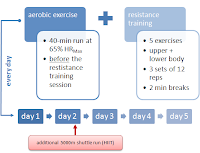 |
| Image 1: Who would have thought that? Dehydroepiandrosterone (DHEA), a demystified anti-aging agent, turns out to be a potent muscle protectant in young men |
5 days of successive "mixed-type exercise" + 100mg/day DHEA
 |
| Figure 1: Graphical illustration of the 5-day exercise regimen |
While the subjects in the control group received 2x50mg caps with flour, the participants in the active arm of the study supplemented 2x50mg of DHEA at breakfast and dinner. Serum insulin, DHEA-S, and testosterone levels, as well as creatine kinase and delayed-onset muscle soreness were measured every 24h.
300% less creatine kinase (=muscle damage) with DHEA
As you can see in figure 1 the supplemental DHEA lead to a rapid yet not fully sustained increase in DHEA-S levels which was accompanied by a statistically significant increase in total testosterone only within the first 2 days of treatment.
 |
| Figure 2: Changes in DHEA-S serum levels and exercise induced elevations of creatine kinase in 16 healthy untrained college aged subjects receiving 100mg/day DHEA or placebo during a 5-day "mixed-type exercise" regimen (data adapted from Liao. 2012) |
[f]asting glucose levels were unaffected by Placebo and DHEA supplementation. [...] The [exercise induced] improvement of glucose tolerance following exercise training did not differ between the Placebo and DHEA groupsand neither the fasting insulin levels, nor the insulin response during the oral glucose tolerance test were affected.
Practical implications & limitations
 |
| Figure 3: DHEA levels peak during puberty and begin to decline in your late twenties (Labrie. 2005). Against that background it would be interesting to see the very same study in a group of say "best-agers" or "baby-boomers", who could potentially derive much greater benefits from a boost in DHEA levels - although studies without exercise intervention yielded very conflicting and mostly disappointing results. |
A note on performance and estrogenic side-effects: An 8-week exercise intervention by Brown et al. which used only 50mg supplemental DHEA per day and a significantly lower workload, as well as longer recovery periods (3x total body workouts per week) did not produce significant changes in any of the study parameters. Neither beneficial ones, such as greater strength increases or hypertrophy, nor negative ones such as increases in estrogen or deteriorations of the lipid profile (Brown. 1999). In 2010, on the other hand, Ostojic et al. report in the Chinese Journal of Physiology that 4 weeks of 100mg supplemental DHEA, despite having no effects on the body composition of the 19-21 year-old soccer players who participated in the study, led to statistically significant increases in total testosterone (+37%), DHEA-S (+197%) and estradiol (+21% compared to the subjects in the placebo group; Ostojic. 2010). The overall significance of these results is yet questionable, since both studies were pretty underpowered (N=10 and N=20 for Brown and Ostojic, respectively) and employed comparatively low-volume / low-intensity exercise protocols with sufficient rest between workouts. It should still be mentioned that the DHEA induced "estrogen dominance", which is one of the most frequent arguments against DHEA supplementation you will hear on pertinent bulletin boards, was not observed in either of the two.
Whether long-term (e.g. year-long) supplementation with DHEA at a dosage of 100mg+ per day is a safe undertaking, does yet likewise remain to be determined as the real-world impact and effect size of the reduced muscle damage and the purported improvements / absence of impairments of glucose tolerance during periods of intense training (more intense than the 3x per week whole body workouts in the Brown study, see red box). That all these effects could help you to train more frequently, gain more strength, build more muscle (less damage) and stay leaner on a bulk (insulin sensitivity), should be obvious. If they don't produce real world results and come at a probably overrated yet certainly existent risk of hormonal imbalances, it is probably safer to stick to what you have learned earlier this week and resort to the 42°C hot tub and some posing (=max. isometric contractions) on your off days, to keep the muscle damage during the next workout at bay.References:
- Asp S, Rohde T, Richter EA. Impaired muscle glycogen resynthesis after a marathon is not caused by decreased muscle GLUT-4 content. J Appl Physiol. 1997 Nov;83(5):1482-5.
- Brown GA, Vukovich MD, Sharp RL, Reifenrath TA, Parsons KA, King DS. Effect of oral DHEA on serum testosterone and adaptations to resistance training in young men. J Appl Physiol. 1999 Dec;87(6):2274-83.
- Costill DL, Pascoe DD, Fink WJ, Robergs RA, Barr SI, Pearson D. Impaired muscle glycogen resynthesis after eccentric exercise. J Appl Physiol. 1990 Jul;69(1):46-50.
- Kamel NS, Gammack J, Cepeda O, Flaherty JH. Antioxidants and hormones as antiaging therapies: high hopes, disappointing results. Cleve Clin J Med. 2006 Dec;73(12):1049-56, 1058.
- Labrie F, Luu-The V, Bélanger A, Lin SX, Simard J, Pelletier G, Labrie C. Is dehydroepiandrosterone a hormone? J Endocrinol. 2005 Nov;187(2):169-96. Review.
- Ostojic SM, Calleja J, Jourkesh M. Effects of short-term dehydroepiandrosterone supplementation on body composition in young athletes. Chin J Physiol. 2010 Feb 28;53(1):19-25.
- Liao YH, Liao KF, Kao CL, Chen CY, Huang CY, Chang WH, Ivy JL, Bernard JR, Lee SD, Kuo CH. Effect of dehydroepiandrosterone administration on recovery from mix-type exercise training-induced muscle damage. Eur J Appl Physiol. 2012 May 16. [Epub ahead of print]










0 comments:
Post a Comment